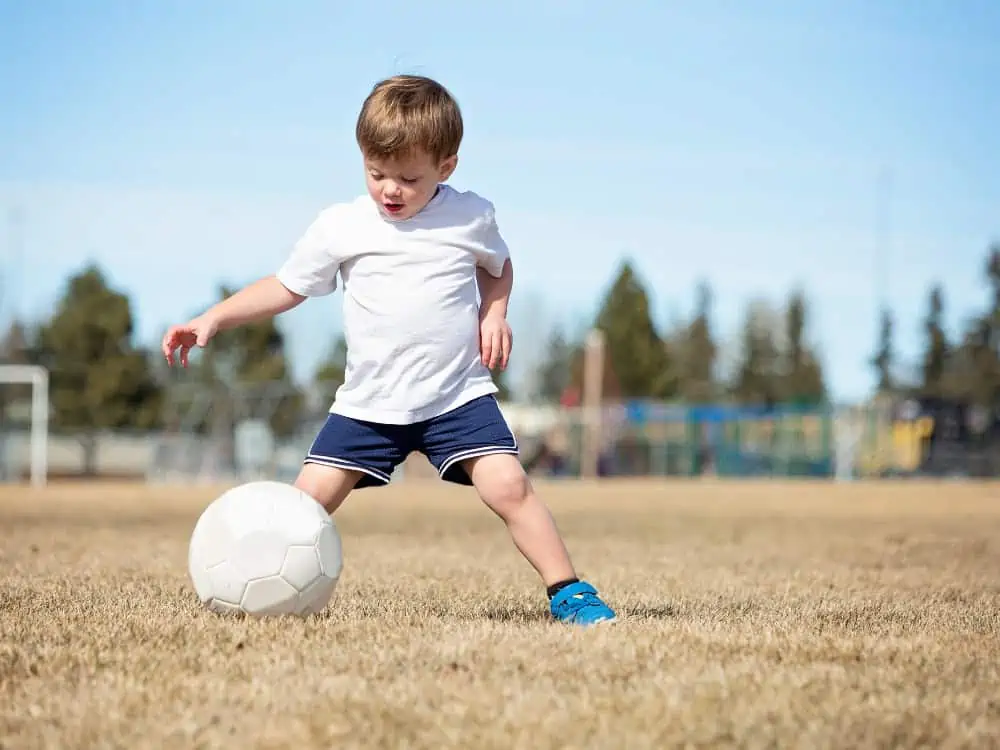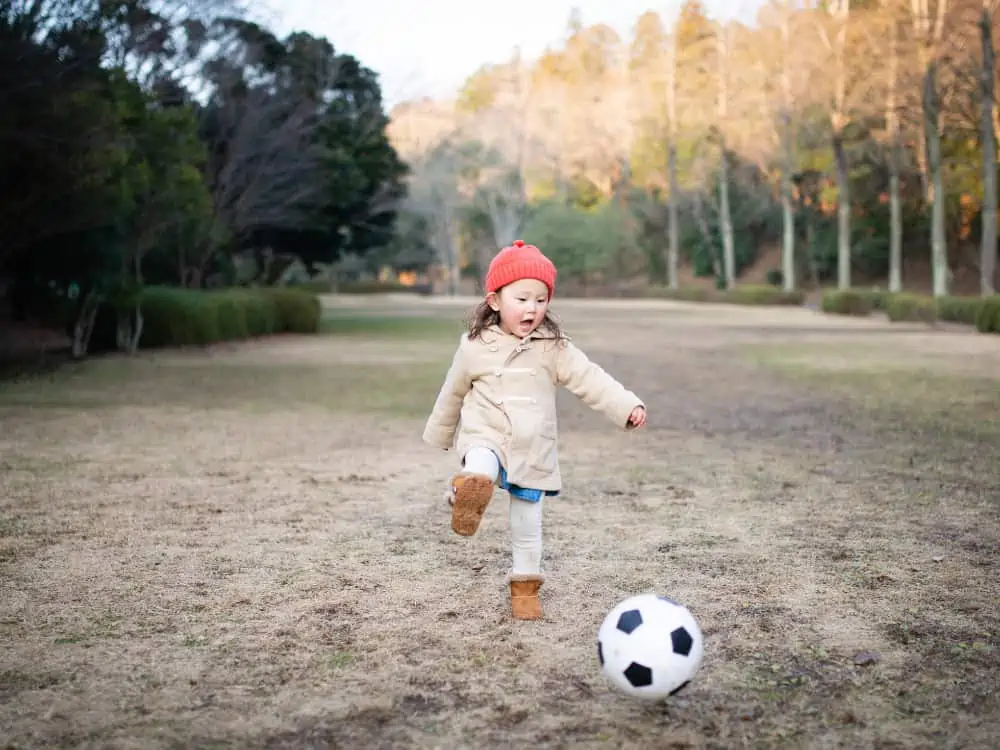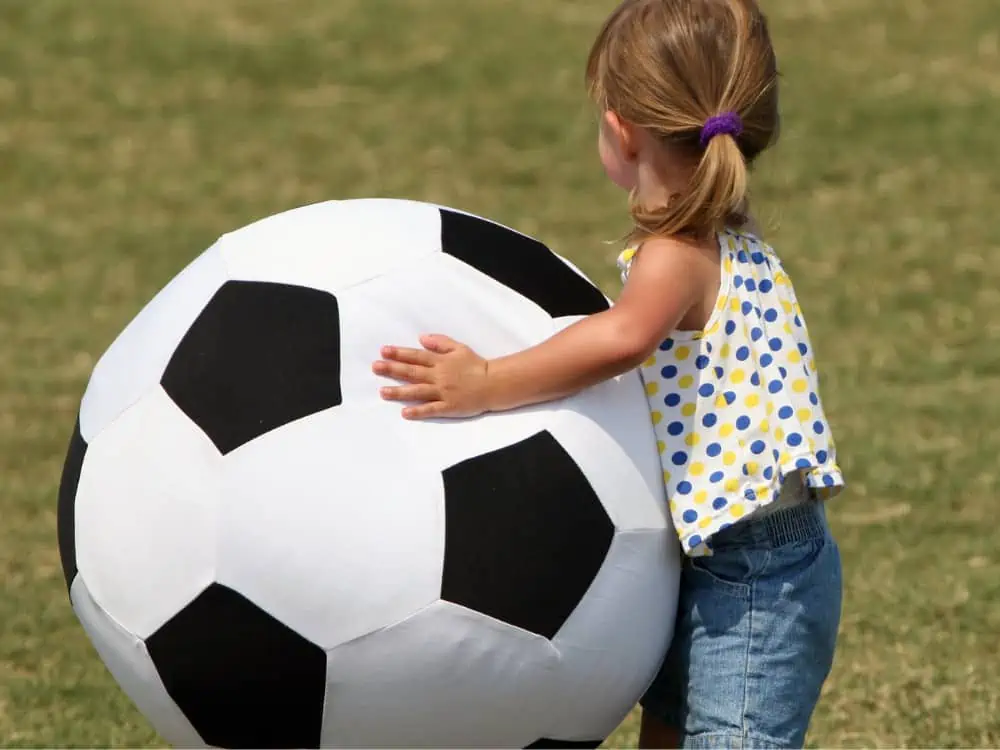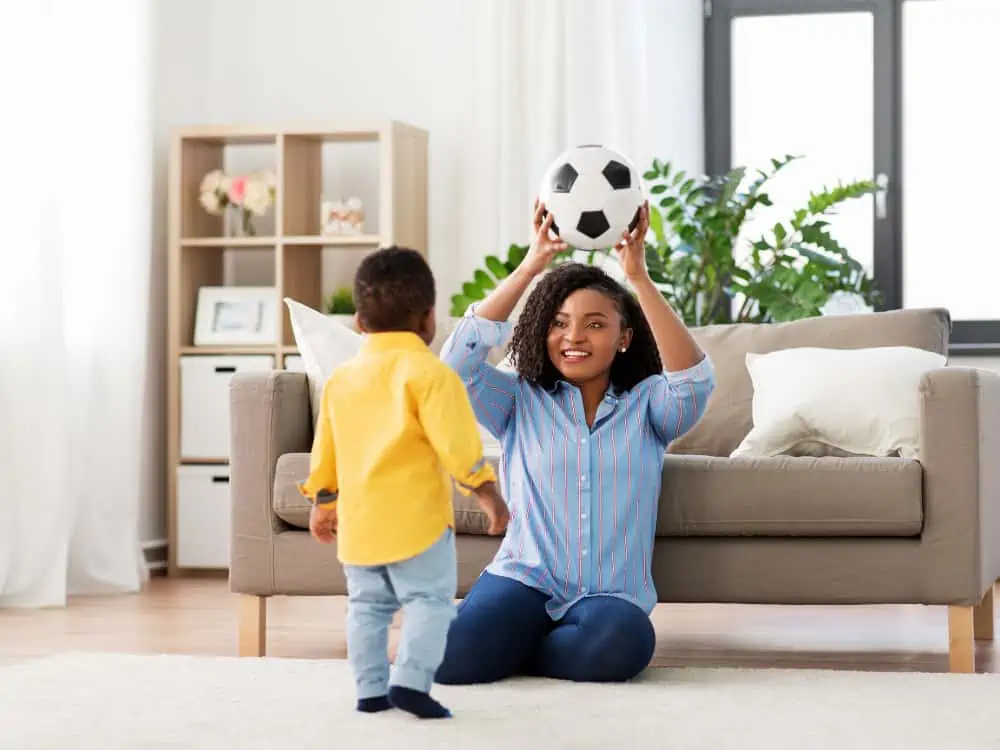Share the post "Soccer for 2-Year-Olds (Perfect Introduction To Sports)"
I’ve got to admit, one of the most trying (yet rewarding) environments I’ve been in as a soccer coach was the summer “peewee” 3 to 5-year-old age bracket.
Many of the kids in the group were 3 or 4, which meant that “soccer practice” was more about touching a ball and having fun than anything else. So, what about 2-year-olds?
Parents are always looking to get young kids into fun activities which is great, but how young is too young?
We’ll outline everything you need to know about soccer for 2-year olds by reviewing:
- Development of toddlers
- How to teach young kids soccer
- Tips for toddler soccer attire
- Where to look for age-appropriate soccer activities
Keep reading to find out how (and if) you can teach your toddler soccer!

Can 2-year-olds Play Soccer?
Okay so first up is the million-dollar question: can a 2-year-old even play soccer?
It all depends on what you mean by “play”. Can a young toddler explain the formation and top tactics while mastering Messi-level skills? Well, no. But that does not mean soccer is hopeless!
Soccer will look different for a 2-year-old, just like it even looks different in 10-year-olds compared to adults. Still, even 2-year olds can demonstrate some basic soccer skills and have fun within the sport.
According to UNICEF, some of the physical milestones you see in two-year-olds include:
- Run, kick a ball, throw a ball overhead
- Climb up and down furntiture without assitance
- Make or copy straight lines and ciricles
Good news! Kids this age are developing many of the necessary physical skills for soccer. While they will all be at different levels of development, this makes soccer a pretty fun activity to let them try.
Want some inspiration? Check out this adorable video of a one-year-old trying out some soccer!
What Sports Can You Put a 2-year-old In?
In addition to soccer, what activities can you put a 2-year-old in? Kids this young are not developmentally ready for organized sports, but there are many toddler-appropriate variations.
Here are some fun ideas:
- Swimming
- Gymnastics
- Dancing
- General activity classes
- Catching/throwing
How Do I Teach My 2-year-old Soccer?
2-year olds can play soccer to some degree, but they will have a lot to learn! For eager parents or coaches, getting started with kids this young may be a challenge.
Here are some helpful tips for teaching your young toddler soccer:
Learn the Game Objects
Remember, kids this age may not know what a ball or cone is, or even all of their own body parts. That means you should spend some time helping them learn body parts and names of relevant items. Encourage them to point when you name the items, as this helps kids learn.
Some words to get started with include:
- Ball
- Cone
- Pinny/bib
- Shoe
- Shoelace
- Foot
- Ankle
- Knee
- Hands
Get Involved
If you think you can just explain a drill and send the child off, you can think again! Children this age love to copy adults and peers. They also tend to enjoy being with other children.
That means one of the best ways to teach a toddler soccer is to play with them and at least one or two friends! Show them what you want to do, model the behavior. Get other kids involved as well.
Patience and Repetition
Toddlers can be a pain, but you’ve got to keep your cool. Remain patient, even if your child doesn’t remember the word or skill you taught them five minutes ago.
It’s all about repetition. You’ll need to repeat the same words, actions, and games many times so that these young kids can progress. That’s very normal! So stay calm and be ready to repeat.
Make It Fun
Soccer at this age is NOT about winning or even being good. It’s about having fun and learning the game.
The top goal to keep in mind is to help the child have fun while getting used to soccer. This means you might not even play games that don’t include using feet on the ball! That’s completely okay.
At this age, kids are still developing basic coordination and body awareness. That’s why things like tag, follow the leader, and red light green light can be so helpful even if they aren’t with a ball.
How Early Can Toddlers Play Soccer?
Essentially, there’s no set age limit as to when a young child can begin learning soccer. Think about how early people start teaching babies how to catch and throw! Soccer works the same way.
Kids can start working on soccer basics essentially when they can walk. Of course, development is on a different timeline for every child, which means your child will progress at his or her own speed.
For example, some kids may be able to walk and “dribble” a soccer ball by age one, whereas others may not have that coordination until they are 1.5 or even 2 years old.
You can naturally introduce some components of soccer when your child is ready. While they may not play an “actual” match until they are 4 or 5, they can begin learning how to kick, dribble, and enjoy the game quite early on.
What Should My 2-year-old Wear to Play Soccer?

If you’re wondering what a child should wear for soccer, we highly recommend this guide on children’s soccer gear! In it, we break down what essentials kids need for soccer.
So, what should 2-year old wear to soccer practice? Here are some ideas:
- Comfortable, flexible clothing.
- Athletic shorts
- A comfortable t-shirt
- A long-sleeve or sweatshirt if cold
- Athletic pants, sweat pants, or leggings if cold
- Mittens and a hat if needed
- Well-fitting athletic shoes (no, they don’t need cleats at this age!)
The above are ideal items, but it’s not always so easy to get toddlers to wear what we want them to. Take a look at the little girl in the photo. Boots aren’t ideal, but as long as your child is safe it’s not worth fighting about the attire.
Looking for a little toddler training outfit inspo? Take a look at pro soccer player Sydney Leroux’s daughter!
What Size Soccer Ball Should a 2-year-old Use?

2-year-olds will have the most fun and the best shot at learning soccer with the correct ball size. But what size soccer ball does a toddler need?
According to Nike.com, kids of all ages can use a size 1 ball for skill development. Other sources recommend this ball for young kids. However, if you have your child in a class they may supply size 3 balls which are for U8 and younger.
Here’s a breakdown of ball size by age:
| Ball Size | Age |
| 1 | U3 |
| 2 | U3-U5 (not always available) |
| 3 | U6-U8 |
| 4 | U9-U12 |
| 5 | U13+ |
How Do You Pick a Soccer Ball?
Looking for the right ball for your toddler? Here are some tips for how to pick a ball:
- Check around the house and with family or friends for extra small balls.
- If purchasing a ball, look for local sales (including yard sales and second-hand stores)
- Set out options for your child based on the proper size.
- Allow your child to pick a ball they like!
You don’t need the highest quality, most durable ball for toddlers! They won’t use it for long or in a professional setting. If you are buying a ball, let them choose one they love and will be excited to use.
Where to Find 2-year-old Soccer Near Me
Most soccer clubs will not have official programs for toddlers. Again, this is because kids this young are not ready for fully organized sports. Still, you can find some toddler-friendly activity programs with a soccer focus.
Here are some places to look for toddler soccer near you:
- Your local park and rec
- The YMCA or other community gym
- “Minis” or “micro” soccer, “little kickers” classes
- Places that offer general toddler activities
- Your local daycare
If you want to play soccer with your two-year-old, some of these soccer games will be perfect, read this next.
The Bottom Line

2-year-olds are not ready for full-blown soccer games, but many are ready to start learning the basics of soccer and having fun within the sport!
Kids this young have different developmental timelines and will all progress differently, the key is to help them enjoy the activity.
Share the post "Soccer for 2-Year-Olds (Perfect Introduction To Sports)"
Joel is a seasoned soccer journalist and analyst with many years of experience in the field. Joel specializes in game analysis, player profiles, transfer news, and has a keen eye for the tactical nuances of the game. He played at various levels in the game and coached teams - he is happy to share his insight with you.



